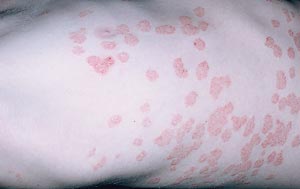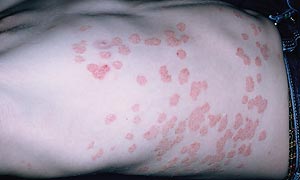A 15-year-old boy with papules on the back, elbows
A 15-year-old boy presented to the clinic with an abrupt onset of round-to-oval papules and plaques with overlying silvery scale, symmetrically distributed along his back and elbows for one week. He complained only of mild pruritus.
On review of systems, you learned that he had a fever, a sore throat and nasal congestion two weeks prior that resolved with acetaminophen. His mother reported that “strep throat” had been circulating at his school.

Did you manage to spot the rash? Click to the next page to find out.
Answer
Guttate psoriasis is a form of psoriasis often seen in children and young adults.
It is typically preceded by group A beta-hemolytic streptococcal oropharyngeal or perianal infection. Lesions may appear a week or longer following an upper respiratory infection and typically appear as an eruption of “teardrop”-shaped papules and plaques with overlying silvery scale, symmetrically distributed over the face, trunk and proximal extensor surfaces. Palms, soles and distal extremities are typically spared. Lesions range from 1 mm to 10 mm in diameter. The differential diagnosis includes pityriasis rosea, secondary syphilis and discoid or nummular eczema.
A throat culture, perianal culture and serum antistreptolysin O titer may confirm infection with group A streptococcus. However, treating the infection with appropriate antibiotics does not necessarily improve guttate psoriasis. Tonsillectomy has also been used for treatment, but evidence is lacking. The eruption often persists for three to four months but may last up to one year. Some guttate psoriasis resolves spontaneously, but a significant number of patients subsequently develop plaque psoriasis.
Several theories exist for why streptococcal infections precipitate guttate psoriasis. Psoriasis is T cell mediated. Streptococcal proteins are thought to secrete super antigens, enhancing the T cell response leading to cytokine release and an acute psoriasis flare. In addition, a genetic predisposition of streptococcal-associated guttate psoriasis on the HLA-C locus, specifically the Cw*0602 allele, has also been reported.
Beyond the controversial treatments of streptococcal disease mentioned above, treatment of chronic guttate psoriasis is similar to other types of psoriasis. Generally, treatment is aimed at avoiding exacerbating factors (strep infections, stress and trauma) and using topical therapy in mild- to-moderate disease.
These include but are not limited to emollients (petrolatum), topical corticosteroids, coal tars (limited use due to odor, color and adverse effects), anthralin, tazarotene and calcipotriene (vitamin D3 analog). Phototherapy, both ultraviolet B (natural sunlight or lightbox therapy) and oral psoralen and ultraviolet A are other options but are limited by concern for the development of nonmelanoma and melanoma skin cancers. Finally, systemic therapy is reserved for recalcitrant psoriasis due to risk and lack of randomized controlled trials and includes cyclosporine, methotrexate, systemic retinoids and etanercept. Patients with chronic psoriasis are usually referred to a dermatologist for management.

For more information:
- Marissa J. Perman, MD, is a PL-III resident at Cincinnati Children’s Hospital Medical Center.
- Leman J, Burden D. Psoriasis in children: a guide to its diagnosis and management. Pediatric Drugs. 2001;3:673-680.
- Lewkowicz D, Gottlieb AB. Pediatric psoriasis and psoriatic arthritis. Dermatologic Therapy. 2004;17:364-375.
- Owen CM, Chalmers RJG, O’Sullivan T, et al. A systematic review of antistreptococcal interventions for guttate and chronic plaque psoriasis. Br J Dermatol. 2000;57(suppl 143):15-24.
- Rogers M. Childhood psoriasis. Curr Opin Pediatr. 2002;14:404-409.
Spot the Rash is a monthly case study featured in Infectious Diseases in Children designed to test your skills in pediatric dermatology issues.
